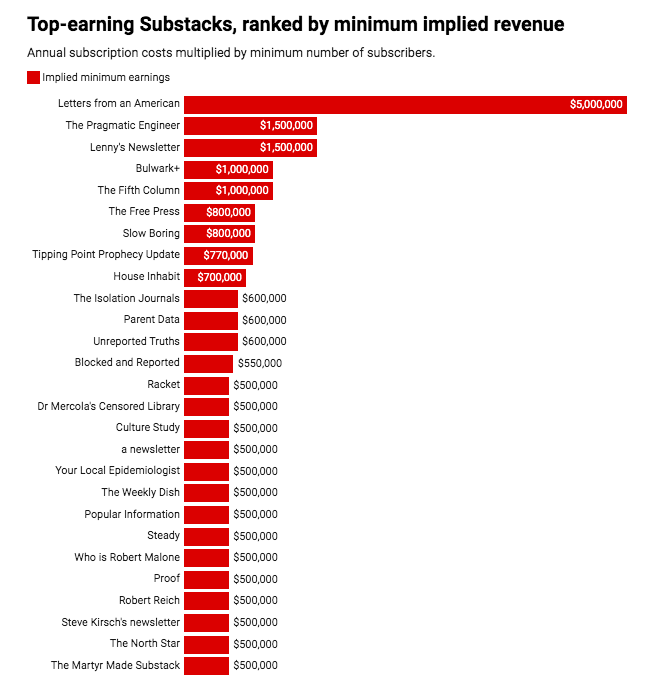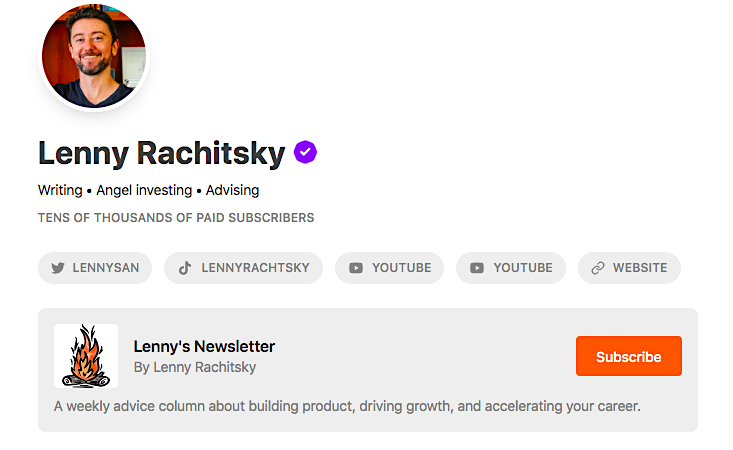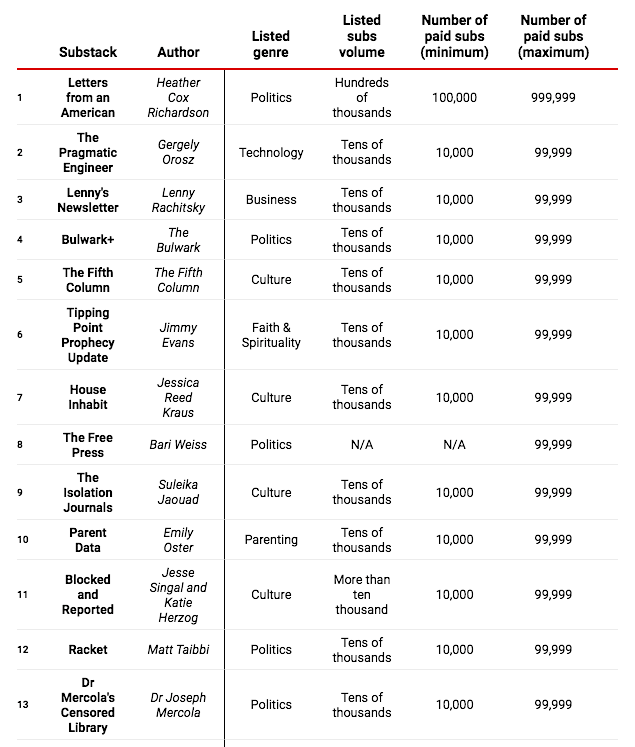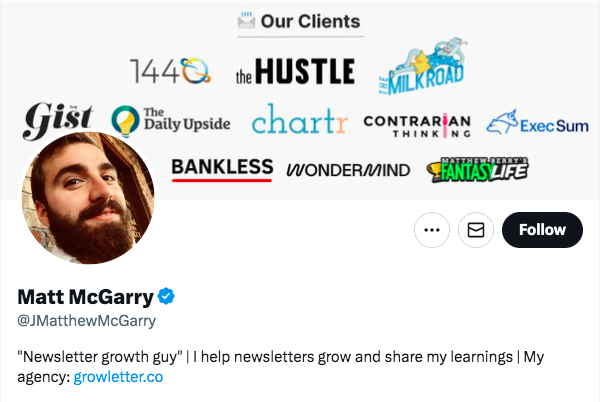Newsletters have become a popular way for individuals and businesses to share their thoughts and connect with their audience.
But is the newsletter business model really profitable?
In this post, we’ll delve into the potential for success with newsletters, exploring the revenue possibilities and benefits and challenges of charging for subscription services.
We can count on them to bring new ideas to the table consistently
How Much Money Do Newsletters Make?
The amount of money a newsletter can make varies significantly based on a range of factors, including the number of subscribers, pricing structure, topic, content quality, and the audience’s willingness to pay.
There are generally two primary methods to ensure profitable newsletters: through advertising and through paid subscriptions.
There are many newsletter platforms/email service providers, including MailChimp, Constant Contact and Medium, but we’ll take a look at Substack, which has grown in popularity quite steadily over the past few years.
According to the PressGazette: Future of Media, the top 27 most profitable newsletters on Substack generate over $22 million annually:

This data shows that people are building significant newsletter businesses using Substack, and they are mainly monetizing through email subscribers who pay for the service. Newsletters such as “Letters from an American,” “The Fifth Column” and “Unreported Truths” are generating millions of dollars each year.
Substack is an online platform that allows independent writers and podcasters to publish directly to their audience and get paid through subscriptions (newsletters can have both paid and free subscribers), most of which are in the neighborhood of $5-10 per month. It’s very simple to start a personal or business newsletter, and it’s easy to make money .
It’s free for writers to get started, and if they choose to turn on paid subscriptions, Substack keeps a 10% cut of revenues for operating costs. The platform is mainly hands-off, aside from providing a payment system, customer support, analytics and design infrastructure.

Take a listen to this podcast episode with Substack founder Chris Best to hear the interesting story of how he created this platform.
Related Content: Beyond the Newsletter: You’ve Got Their Email, Now What?
Paid Subscribers Equal More Active Subscribers
Although it might sound counterintuitive, paid newsletters produce more active subscribers compared to free newsletters. Here’s why.
Paid subscribers have a higher level of commitment to the content. When someone shells out cash for a subscription, they are making an investment in the expert content and are therefore more likely to engage with it. They have shown a willingness to pay for the value they believe they will receive from the newsletter.
This level of commitment often leads to higher engagement rates and more action taken on marketing-related content. On the other hand, free newsletters tend to attract a larger subscriber base but may have lower engagement rates since the barrier to entry is lower.
As trust in the media declines to a record low of 26%, more than 90% of Americans subscribe to at least one newsletter.
Paid newsletters offer a modern business model version of charging for publications such as The New York Times or The Wall Street Journal.
Furthermore, paid newsletters often have a more focused audience. Since subscribers are paying for the content, they are more likely to have a specific interest in the subject matter. This can lead to a more invested community within the newsletter.
Paid newsletters can also offer exclusive content, resources or access to the author, which further incentivizes subscribers to engage with the content.
Related Content: The Fastest and Easiest Way to Increase Your Email Open Rates
Multiple Monetization Opportunities
So how much do newsletters make? Enough to earn your entire living from your newsletter business – if you put in the work and deliver top-notch content.
Newsletters can easily be monetized through various methods, such as subscriptions, ads, etc. Here’s a brief overview of each:
- Paid subscriptions: This is one of the most common ways to monetize newsletters. Subscribers pay a fee to receive your newsletter on a regular basis. You can charge a monthly or annual fee for access to premium content, exclusive updates or other perks. Subscription rates can vary widely, but it’s common to see prices ranging from $5 to $50 per month, depending on the content’s value. So if a newsletter has 1,000 subscribers paying $10 a month, that would generate $10,000 in revenue per month or $120,000 per year.
- Ads: Another way to monetize newsletters is by displaying ads. You can either sell ad space directly to advertisers or use ad networks such as Google AdSense to automatically display relevant ads to your readers. Keep in mind that too many ads can drive away readers, so it’s important to find the right balance.
- Selling products/services: You can also use newsletters to sell products or services related to your niche. For example, if you run a cooking newsletter, you could sell cookbooks, kitchen gadgets or cooking classes.
- Sponsorship: In some cases, companies might sponsor newsletters, especially those with a significant following or a highly engaged audience within a specific niche. The sponsorship could be for one edition, several, or an ongoing agreement.
- Affiliate marketing: Some newsletters include product recommendations with affiliate links, where the newsletter publisher earns a commission on any sales made through those links.
Since most newsletters offer a free version, the key to monetizing newsletters is to provide extra value to your paid readers and build a loyal subscriber base. This could be carefully curated content in your industry (tech news, health stories, personal growth, etc.), valuable information they can’t find anywhere else, emerging trends with an expert POV, exclusive interviews, or in-depth reporting on breaking news.
If you consistently deliver high-quality content (and don’t forget that engaging subject line for better open rates; this is still email marketing, after all!) and interact with your audience, you’ll be able to monetize your newsletter in a way that benefits both you and your subscribers.
“Lenny’s Newsletter” on Substack is an example of a successful newsletter business that provides value to readers by offering unique insights and advice from a former product manager at Airbnb:

He tackles reader questions about products, business growth, career growth and anything else that readers want to know about. His paid subscribers get the weekly post and an invite to a subscriber-only Slack community (10K+ members). Non-paid subscribers get one free monthly post.
Need help monetizing your newsletter? We’ve done it for our own newsletter, and Single Grain’s marketing experts can do it for you, too!👇
Benefits and Challenges of Running a Newsletter Business
Running a profitable newsletter as a business offers numerous benefits, from building a loyal audience to monetizing your content and expertise. However, it also comes with its fair share of challenges. Let’s explore both sides of this business model.
Benefits of Running a Newsletter Business
- Direct Connection with Audience: Newsletters allow for direct engagement with your audience right in their inbox, creating a personal connection that can be more challenging to achieve through social media or other platforms. This connection can foster loyalty and engagement, contributing to the long-term success of your newsletter.
- Control over Monetization: Unlike social media platforms, where changes in algorithms can dramatically affect earnings, newsletters allow you greater control over your revenue streams. Whether it’s through subscriptions, sponsorships or affiliate marketing, you’re in charge of how you monetize your newsletter.
- Flexibility and Autonomy: With a newsletter, you have the freedom to write about what interests you and to set your own publishing schedule. You’re not beholden to an editor or a publisher — you are your own boss.
- Building Your Personal Brand: A successful newsletter can significantly boost your personal brand, enhancing your reputation in your field, and potentially opening up new opportunities, such as speaking engagements or consulting work.
Challenges of Running a Newsletter Business
- Growing a Subscriber Base: One of the most significant challenges in running a newsletter is attracting and retaining a substantial subscriber base. It requires consistent, high-quality content and effective marketing strategies. Additionally, converting free subscribers to paying ones can also be difficult.
- Time and Effort: Running a successful newsletter can be time-consuming. It involves not just writing the newsletter, but also handling administrative tasks, marketing, audience engagement, and more.
- Sustaining Engagement: Keeping your audience engaged over time can be a challenge. Readers’ inboxes are often cluttered, and ensuring that your newsletter stands out and continues to captivate your audience requires creativity and a deep understanding of your audience’s needs and interests.
- Financial Instability: While newsletters can be profitable, it often takes time to generate substantial income. Especially in the early stages, monthly recurring revenue can be unpredictable. For those considering making their newsletter their primary income source, this financial instability can be a significant concern.
Understanding both the benefits and challenges of running a paid newsletter business is crucial for anyone considering this path. It’s not for everyone, but if you have a passion for your topic, a knack for writing, and a willingness to put in the work, it can definitely be a rewarding venture.
Learn More: 4 Ways to Get More Newsletter Subscription Sign-Ups in 2023
Success Stories of Newsletters as a Business
Here’s what a lot of businesses don’t talk about with newsletters: When you get someone to subscribe and they pay you a little bit of money, then any time you push out anything marking related to them, they’re much more likely to take action on it.
One of the biggest SaaS conferences in the world is SaaStr, and Jason Lemkin, the founder, says that the one thing that’s been most constant for them is that whenever they push out a newsletter, they know they’re going to get sales. Now, that doesn’t mean you can just push out a newsletter every time and say “Buy our stuff!” Obviously, you still have to provide a lot of value in your newsletter.
A huge newsletter business right now is The Agora, which generates over a billion dollars in revenue. They own about 20-40 different newsletters and make about $20-50 million each week. That’s a lot of income for a newsletter business.
Other examples include Axios, which did so well it sold for $525 million to Cox Enterprises, its most recent lead investor, and “The Hustle,” the popular newsletter from business and tech media startup of the same name, which sold for about $27 million to HubSpot:

The highest-earning newsletters on Substack and their genre and number of paid subs are:

So are newsletters profitable? These examples demonstrate that newsletters can certainly be a significant business opportunity when executed correctly. To really get seen (which is one of the challenges we mentioned above), you’ll have to execute digital marketing strategies (SEO, PPC, social media marketing, not to mention a good email marketing strategy) to get your business newsletter out there.
Related Content: How to Create a High-Value Lead Magnet to Quickly Grow Your Email List
The Importance of Providing Value
While monetizing a newsletter is essential, providing value is equally – or even more – important. Without something of substance in the content, people will soon stop reading and cancel their subscriptions.
When newsletters offer value, subscribers are more likely to share the newsletter with their networks, resulting in a broader reach and potential for more subscribers.
Get inspired by these 10 tips for providing value in a newsletter:
- Exclusive content: Offer unique content that is not available anywhere else.
- Expert insights: Share insights and opinions from industry experts or thought leaders in your field.
- Practical tips: Provide actionable advice and tips that readers can apply to their lives or businesses.
- News and updates: Keep subscribers informed on the latest news and updates in your industry or niche.
- Curated content: Share relevant articles, videos or podcasts that your readers may find interesting or helpful.
- Case studies and success stories: Share real-world examples of how your advice or products have helped others achieve success.
- Q&A and Ask Me Anything (AMA) sessions: Engage with your readers by answering their questions or hosting live Q&A sessions.
- Community building: Foster a sense of community among your subscribers by encouraging them to share their thoughts, opinions, and experiences.
- Personalization: Use data and insights to personalize your newsletter content based on subscribers’ interests and preferences.
- Discounts and promotions: Offer special discounts or promotions to your subscribers as a way of thanking them for their loyalty.
Working with a newsletter expert such as Matt McGarry can help businesses grow their newsletters. He has helped “The Hustle” and “The Morning Brew” grow their newsletter audiences and can offer valuable insights and strategies to businesses looking to do the same.

Last Word on the Newsletter Business
Newsletters can be a lucrative business opportunity when executed correctly. By monetizing through subscription services, ads and selling products or services, businesses can generate significant revenue.
Just remember that providing value to subscribers is crucial to keep them engaged and subscribed. With the right incentives and a focus on providing value to subscribers, newsletters can be a successful business opportunity.
If you’re ready to expand the reach of your newsletter, Single Grain’s marketing experts can help!👇
Newsletters FAQs
-
Do people make money from newsletters?
Yes, people can definitely make money from newsletters. There are several different methods to monetize newsletters, including but not limited to:
- Subscription Fees: If you provide unique, valuable and well-written content, you can charge a subscription fee. Most people, in fact, offer both free and paid subscriptions. An example is the newsletter from “Stratechery” by Ben Thompson, which yielded about $3 million in revenue in 2020.
- Sponsorship: If you have a large number of subscribers or a highly targeted niche audience, you could attract the interest of businesses who want to sponsor your newsletter or place ads in it. Keep in mind that this may cause you to lose some subscribers if your content is too ad-heavy or too salesy.
- Affiliate Marketing: There’s also the option of using affiliate links in your newsletter. This means that if a reader clicks on the link and makes a purchase, you get a commission. Amazon’s affiliate program is a common example, but there are plenty of other affiliate programs, too.
- Selling Products or Services: If you have your own products or services, your newsletter can be a great way to promote them. These could be physical products like clothes fitness equipment, digital products like e-books or courses, or services like consulting or coaching.
- Donations or Patronage: Some newsletter creators ask their readers for donations or offer premium content available only for paying subs through platforms like Patreon. You’ve probably seen this tactic on YouTube a lot already.
- Events: Some newsletter authors hold events (either virtual or in-person) related to the content of their newsletter. Charging an entry fee or attracting event sponsors can provide another revenue stream.
For all these methods, the key is to provide value to your readers. If your readers find your content valuable, they’ll be more likely to pay for a subscription, click on an affiliate link, buy a product you recommend, or donate to support your work.
-
Why are newsletters good for business?
Newsletters (via email) are an excellent digital marketing tactic because you can communicate directly with your audience in a much more personal way than, say, a newspaper.
Here are some more specific reasons why newsletters are good for business:
- Building Relationships: Newsletters are a powerful way to stay in touch with customers and potential customers and let them know about business updates, new products or valuable info related to your business (like a law firm that writes blog posts about specific legal issues, such as how to’s or step-by-step guides).
- Increasing Brand Awareness: Regular newsletters keep your brand at the top of your customers’ minds. When the time comes for a customer to make a purchase, they’re more likely to choose a brand they already recognize.
- Driving Traffic to Your Website: Newsletters often include links to blog posts, product pages or other content on your website. This can help increase traffic to your site, not to mention improve its search engine ranking. You can also promote new products, share special offers or otherwise encourage your subscribers to make a purchase.
- Establishing Authority: By sharing valuable, expert-written content in your newsletters, you can position your business as an authority in your industry. This build credibility with your audience.
- Gathering Customer Insights: Newsletters can also provide useful data about your customers. For example, you can see which links get the most clicks, giving you insight into what topics or products your customers are most interested in.
- Cost-Effective Marketing: And, finally, compared to traditional marketing channels like print, TV or direct mail, email newsletters are relatively inexpensive to produce and distribute, making them a cost-effective way of reaching your audience.
-
Do newsletters increase sales?
Yes, newsletters can be a great way to increase sales for a business. They serve as a direct line of communication to a receptive audience, which provides opportunities to promote products or services, offer exclusive discounts, and educate subscribers about product benefits.
Also, they can be used for upselling and cross-selling, and for re-engaging inactive customers. The key to success lies in offering valuable content that encourages readers to take action. When used strategically, newsletters can significantly contribute to boosting a business’s sales.
-
Are newsletters still effective?
Yes, newsletters remain highly relevant and effective for several reasons.
Despite the rise of social media and other digital communication channels, they can be effective tools for maintaining and deepening relationships, driving engagement, and promoting products or services.
Moreover, the effectiveness of newsletters can be easily tracked and improved over time using various analytics tools. Plus, platforms like Substack or Revue have made it easier for individuals and businesses to monetize their newsletters.
It’s also worth noting that newsletters offer a personal way to reach an audience, bypassing algorithm-driven feeds of social media. This direct line to subscribers can be particularly effective for targeted marketing and building community.
-
Is a newsletter a good business?
Yes, a newsletter can be a good business. With the right strategy and content, a newsletter business can build a dedicated audience, offer targeted advertising, and provide valuable information or entertainment, making it a viable and often cost-effective business model.
-
How profitable are newsletters?
The profitability of newsletters varies widely. The most profitable newsletters leverage a mix of revenue streams such as subscriptions, sponsorships, and advertisements. Success depends on factors like niche, audience size, and engagement rates.
But here’s a general range:
- Small to Medium Newsletters: These often earn a few hundred to several thousand dollars per month. For instance, a newsletter with a modest subscriber base might make $500 to $5,000 monthly through a combination of advertising, sponsorships and affiliate marketing.
- Larger, More Established Newsletters: These can earn significantly more, often ranging from $10,000 to $50,000 per month. This higher income is usually due to a larger subscriber base, higher engagement rates, and more lucrative advertising or sponsorship deals.
- Top-Tier Newsletters: The most profitable newsletters, especially those in high-demand niches with large, dedicated audiences, can generate six to seven figures annually. These figures are typically reached through premium subscription models, high-value sponsorships, and targeted advertising.
-
How do 7 figure newsletters make money?
Seven-figure newsletters make money through a combination of methods. They often have a large, engaged subscriber base, allowing them to generate significant revenue from subscriptions, premium content, sponsorships and targeted advertising.
These high-earning newsletters excel in delivering valuable, unique content that resonates with their audience, driving both subscriptions and advertising opportunities.


